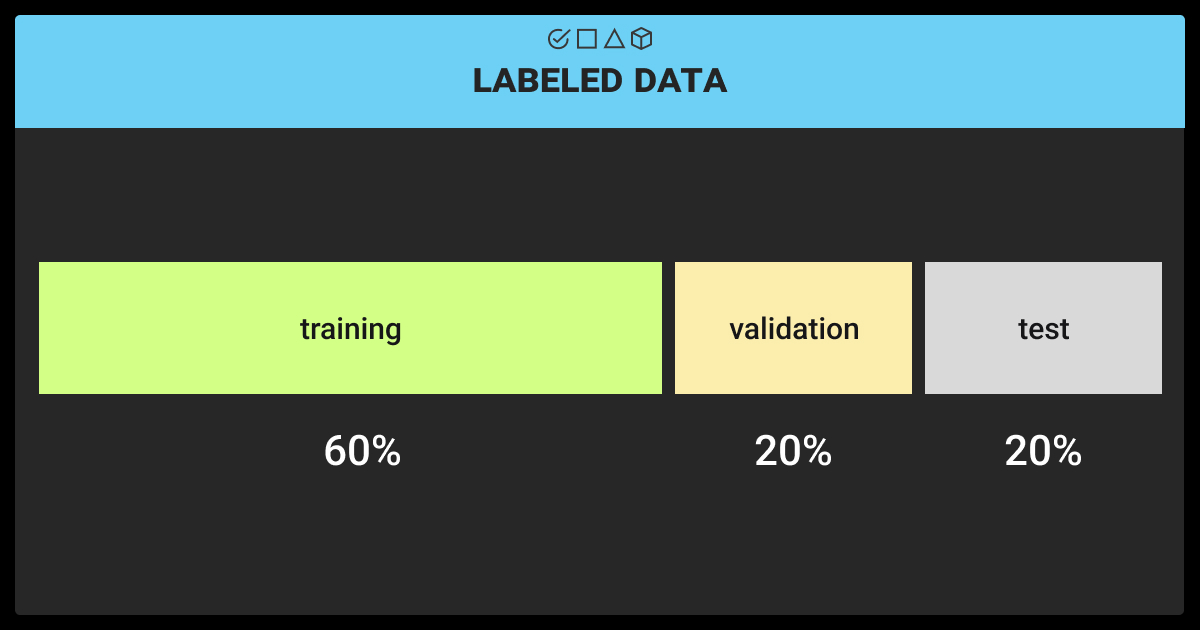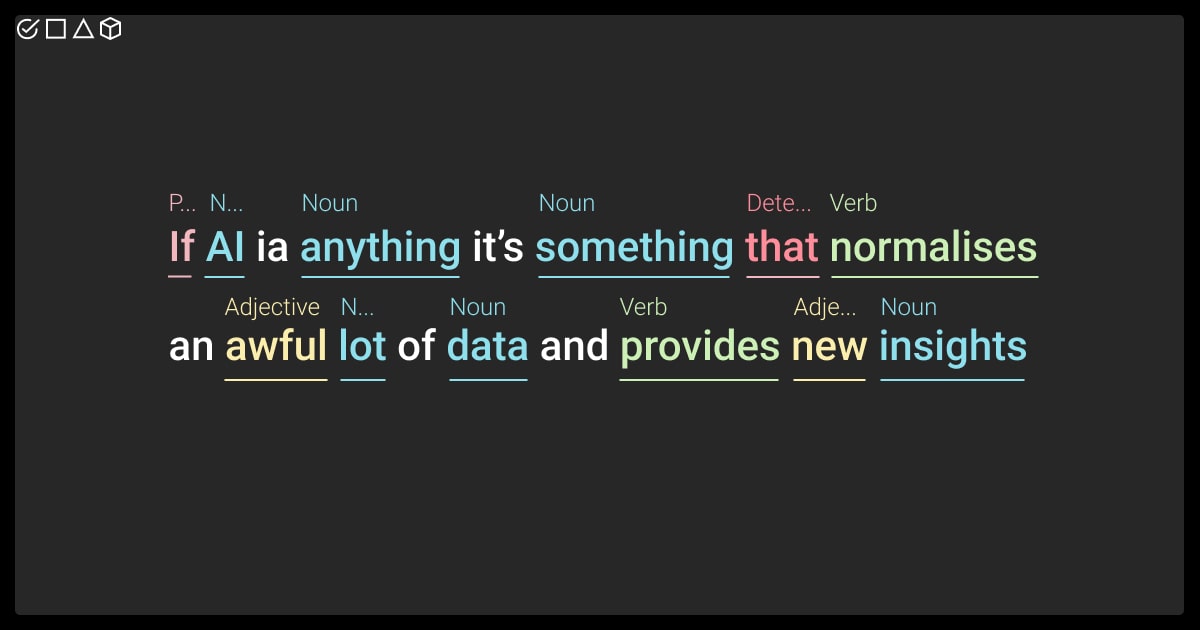How to Label Data for Machine Learning Projects?

Today, tackling technological challenges feels a lot like what Andrew McAfee, Co-director of the MIT initiative, said: “The world is one big data problem.” Whether we’re debating our origins or diving into the heart of AI, one thing is clear — data is at the core of everything.
Meanwhile, data labeling for machine learning became pivotal for streamlining the way we handle this massive data puzzle. Yet, most companies still struggle to get this process done right for their ML projects. Those that do know how to label data for machine learning are already in the pace for speeding up the development of intelligent and dependable AI systems.
Our expert team shares some key insights and tips on the process of data labeling in machine learning.
Data Labeling in the Machine Learning Pipeline

Here’s a breakdown of how data labeling fits in the ML pipeline:
Data collection: The pipeline begins by gathering the raw data you want your model to learn from. Data collection implies gathering raw, unstructured data (images, videos, text documents, or audio files) that needs to be labeled. The more data you have, the more precise your model will be.
Here’s where you can gather data for your ML project:
Freelance fieldwork: If you require specific data that isn’t readily available online, hiring freelance data collection specialists can be a valuable option.
Public datasets: There’s a wealth of free data available online, with a few top resources to explore, such as Kaggle, UCI Machine Learning Repository, and Data.gov.
Paid Datasets: For highly specialized data or access to exclusive information, investing in paid datasets can be worthwhile.
Data cleaning: The next step is preparing data for supervised ML by cleaning it. That is, eliminating irrelevant, duplicate, or corrupted files to uphold data quality, as well as identifying and correcting (or deleting) errors, noise, and missing values. Data cleaning is an ongoing process that happens throughout the development and potentially even deployment of your machine learning project.
The final step here is storing your collected data the right way and in the right format. Data is usually stored in a data warehouse (traditional data warehouses like Oracle Exadata, Teradata, or cloud-based services like Amazon Redshift) or data lake (cloud-based solutions like Amazon S3 with AWS Glue or Azure Data Lake Storage with Azure Databricks), for easier management. We suggest choosing the storage system able to meet the needs of your model as the data increases.
Data labeling: Here, the data is labeled with relevant information to create a labeled training dataset. Let’s start with data labeling for Computer Vision models. If you’re building a computer vision system, you deal with visual data, such as image, videos, and sensor data.
Model training: Once you’ve labeled data in machine learning and checked the quality and consistency of the performed annotations, it’s time to put the labeled dataset to use. By analyzing the labeled data, the model learns to identify patterns and relationships between the data and the labels.
More specifically, the dataset can now be split for model training, testing, and validation, respectively, following this useful rule of thumb:
Model evaluation & deployment: Once trained, the model’s performance is evaluated on a separate dataset. If successful, the model can then be deployed for real-world use.
Most ML models use supervised learning, where an algorithm maps inputs to outputs based on a set of labeled data. This involves humans labeling raw, unlabeled data, such as tagging a set of images for an autonomous system with information about obstacles on the road. The model learns from these labeled examples to decipher patterns in that data during a process called model training. The resulting trained model can then make predictions on new data.
The accurately labeled data in machine learning used for training and assessing a model is often referred to as “ground truth.” The model’s accuracy relies on the precision of this ground truth, emphasizing the importance of investing time and resources in accurate data labeling.
How Does Data Labeling Work?
Most ML models use supervised learning, where an algorithm maps inputs to outputs based on a set of labeled data by humans. The model learns from these labeled examples to decipher patterns in that data during a process called model training. The model can then make predictions on new data.
Labeled data used for training and assessing an ML model is often referred to as “ground truth.” The model’s accuracy relies on the precision of this ground truth, emphasizing the importance of investing time and resources in accurate data labeling.
With high-quality annotations on hand, data scientists can identify the important features within the data. However, common dataset labeling pitfalls can impede this crucial process.
More specifically, public datasets often lack relevance or fail to provide project-specific data, and in-house labeling can be time-consuming and resource-heavy. Automated tools, while helpful, don’t guarantee 100% accuracy or offer all the features you need. And even with automation, human oversight is still a must.
Next, we reveal the 6 steps to overcome these challenges when labeling datasets for machine learning.
6 Steps to Overcome Data Labeling Challenges: Label Your Data Best Practices

In the study by Hivemind, a managed annotation workforce demonstrated a 25% higher accuracy rate compared to crowdsourced annotators, who made over 10 times as many errors.
This means that building and managing your own in-house data labeling team can significantly improve the quality of your training data. To help you achieve efficient in-house labeling, we’ve gathered our time-proven steps to help you navigate the main challenges in data labeling:
Building a solid data annotation strategy
Data annotation projects usually fall under one of the categories: data labeling for initial ML model training, data labeling for ML model fine-tuning, and human-in-the-loop (HITL) and active learning.
Your data annotation process must be scalable, well-organized, and efficient. It’s an iterative step in the entire ML pipeline, involving constant monitoring, feedback, optimization, and testing.
Maintaining high quality of labeled datasets
Regular QA procedures are crucial to verify label accuracy and consistency. This includes reviewing random data samples or employing validation techniques. The labeling process also follows an iterative loop, with initial results reviewed and feedback incorporated for further label refinement.
Keeping the machine learning datasets secure
To ensure labeled data security, you should prioritize a multi-layered approach encompassing:
Physical security: Secure facilities with manned security, access restrictions, video surveillance, ID badges, and limitations on personal belongings in sensitive areas.
Employee training & vetting: Consistent training on data security risks, phishing, password management, and ethics. Background checks and requiring adherence to security policies and NDAs.
Technical security: Strong encryption (AES-256), secure annotation software, multifactor authentication, role-based access control to limit data exposure, and restricted internet access.
Cybersecurity: Proprietary communication tools, penetration testing, and external security audits.
Data compliance: Adherence to industry regulations like GDPR, CCPA, and ISO 27001 with ongoing updates to maintain compliance.
Hiring data annotators
Inconsistent data annotations can cripple the model's performance. To tackle this, you need to hire skilled data annotators. You can build your team by leveraging your network through job boards and social media, or look beyond it by partnering with data annotation companies or targeted online ads. By choosing the right hiring approach, you'll assemble a strong data annotation team to fuel your ML project’s success.
Training data annotators
Despite the level of automation we’ve reached so far, data labeling cannot do without human intelligence. Always make sure to have human experts on your team. They bring the context, expertise, experience, and reasoning to streamline the automated workflow.
Training a team of annotators to use a specific labeling tool and follow the project guidelines. When dealing with a specific type of data and edge cases in data labeling, you need to hire subject-matter experts (SMEs) for complex domains, like healthcare, finance, scientific research, or for multilingual tasks in NLP.
Choosing between in-house vs. outsourced data labeling
Choosing between in-house vs. outsourced data labeling depends on your specific needs and priorities. Consider the size and complexity of your dataset, the turnaround time required, and the level of control you need over the labeling process.
In short, outsourcing works for projects involving large datasets with simpler labeling tasks and a focus on faster turnaround times. However, this strategy might pose potential quality issues. A dedicated in-house team, in contrast, is suitable for those looking for a balance between cost, quality, and scalability, especially for projects requiring domain expertise.
You can learn more about this in our article about in-house vs. outsourced data annotation.
Labeling data for ML training is an iterative process, involving constant monitoring, feedback, optimization, and testing. If you’re dealing with a large dataset or a very specific use case and seek professional help, contact Label Your Data!
Data Labeling for Computer Vision Models

The process of labeling data for machine learning usually falls under two categories: machine vision tasks and NLP tasks. If you’re building a computer vision system, you deal with visual data, such as images and videos. Here, you can use more than one type of data labeling tasks to generate a training dataset, including:
Image Categorization: Allows training your ML model to group images into classes, allowing further identification of objects in photos.
Semantic Segmentation: Associates each pixel with an object class, creating a map for machine learning to recognize separate objects in an image.
2D Boxes (Bounding Boxes): This labeling type implies drawing frames around objects for a model to classify them into predefined categories.
3D Cuboids: Extends 2D boxes by adding a third dimension, providing size, position, rotation, and movement prediction for objects.
Polygonal Annotation: Draws complex outlines around objects, training machines to recognize objects based on their shape.
Keypoint Annotation: Defines main points for natural objects, training ML algorithms for shapes, movement, and versatility in facial recognition, sports tracking, etc.
Object Tracking: This type is often used in video labeling, breaking down frames, and detecting objects to link their positions across different frames.
As such, when labeling data for ML training, keep in mind the specific task you want your ML model to perform. You can use your labeled dataset to build a computer vision model for identifying facial expressions, recognizing handwritten text, segmenting medical images, or even predicting anomalies in satellite imagery. Everything your heart desires.
Data Labeling for NLP Models

Labeling data for machine learning can get trickier when working with textual or audio data. The reason for this is simple: inherent subjectivity and complexity in language. The key challenge here is the need for linguistic knowledge.
Creating a training dataset for natural language processing (NLP) involves manually annotating key text segments or applying specific labels. This includes tasks such as determining sentiment, identifying parts of speech, categorizing proper nouns like locations and individuals, and recognizing text within images, PDFs, or other documents.
The main NLP labeling tasks include:
Text Classification: Groups texts based on content using key phrases and words as tags (e.g., automatic email filters categorizing messages).
OCR (Optical Character Recognition): Converts images of text (typed or handwritten) into machine-readable text, applied in business, license plate scanning, and language translation
NER (Named Entity Recognition): Detects and categorizes specific words or phrases in text, automating the extraction of information like names, places, dates, prices, and order numbers.
Intent/Sentiment Analysis: Combines sentiment analysis (classifying tone as positive, neutral, or negative) and intent analysis (identifying hidden intentions) for applications in market research, public opinion monitoring, brand reputation, and customer reviews.
Audio-To-Text Transcription: Teaches ML model to transform audio into text, useful for transcribing messages and integrating with other NLP tasks like intent and sentiment analysis for voice recognition in virtual assistants.
“NLP can be challenging as it involves reading texts and thinking critically about the content while labeling data. Additionally, when working with texts in a foreign language, accurate translation becomes crucial to execute the task correctly. This is why, in some cases, NLP may demand more resources to achieve success in your ML project.”
Ivan Lebediev
Integration Specialist at Label Your Data
Let’s Sum Up
Effective ML models rely on extensive amounts of top-notch training data. Data labeling for machine learning allows us to get this training data for developing smart solutions in either computer vision or NLP domain. However, annotating data for ML models is frequently a costly, intricate, and time-intensive undertaking.
With our guide, you get all the necessary information about how to label a dataset for machine learning, and even take on the challenge and try to label a dataset on your own.
If any issues arise, consider streamlining your machine learning project by leveraging our professional data labeling services. Send your data to us and get a free pilot to see how it works!
FAQ
Does machine learning always need labeled data?
Not necessarily. Machines can leverage both labeled and unlabeled data for model training purposes. However, while labeled data is commonly used in supervised learning, machine learning techniques such as unsupervised and reinforcement learning can operate without labeled data.
What type of data is best for machine learning?
Data can take different forms, but machine learning mainly uses four types: numerical data, categorical data, time series data, and text data. For NLP projects, you need text or audio data, while for computer vision you use visual data, such as images and videos. The best type of data, though, depends on the specific task, but generally, you need well-organized, representative, and diverse datasets.
Which type of machine learning uses labeled data?
Supervised learning is a type of machine learning that uses labeled data to train algorithms, enabling them to generalize patterns and make predictions on new, unseen data.
Written by
Karyna is the CEO of Label Your Data, a company specializing in data labeling solutions for machine learning projects. With a strong background in machine learning, she frequently collaborates with editors to share her expertise through articles, whitepapers, and presentations.


